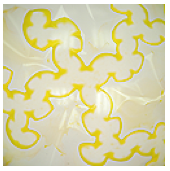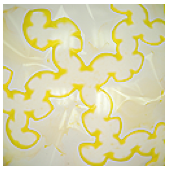It’s a wrap
We discover as children that an orange peel cannot be flattened without tearing it, providing an early lesson in geometry. The same geometrical constraint has been frustrating cartographers for centuries: there is no way of making a flat map of Earth without stretching continents. Now, writing in Physical Review Letters, scientists in France report an experimental look at the converse of this lesson: taking a flat sheet and trying to make it stick to a curved surface.
Jérémy Hure and colleagues at the Pierre and Marie Curie University and Diderot University study the adhesion patterns that form when wrapping thin sheets of elastic polypropylene over the top half of plastic or glass spheres. A coating of ethanol on the spheres promotes the adherence of the sheets, while a fluorescent dye in the ethanol makes visible the boundaries between stuck and unstuck parts.
Images of the adhered sheets reveal patterns of unstuck regions, or “blisters,” that evolve from simple to intricate, depending on the sheet’s size and thickness, and the energy associated with stretching, bending, and adhering it. Because all of these parameters are well defined in Hure et al.’s experiments, they can compare their experiments with a simple model. The results could be useful in micro- and nanotechnologies to conform materials of varying degrees of elasticity to a curved object. – Jessica Thomas





